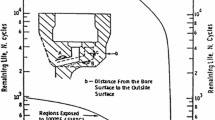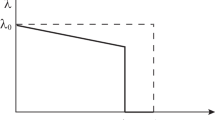Abstract
This paper focuses on problems associated with aircraft sustainment-related issues and illustrates how cracks, that grow from small naturally occurring material and manufacturing discontinuities in operational aircraft, behave. It also explains how, in accordance with the US Damage Tolerant Design Handbook, the size of the initiating flaw is mandated, e.g. a 1.27-mm-deep semi-circular surface crack for a crack emanating from a cut out in a thick structure, a 3.175-mm-deep semi-circular surface crack in thick structure, etc. It is subsequently shown that, for cracks in (two) full-scale aircraft tests that arose from either small manufacturing defects or etch pits, the use of da/dN versus ∆K data obtained from ASTM E647 tests on long cracks to determine the number of cycles to failure from the mandated initial crack size can lead to the life being significantly under-estimated and therefore to an unnecessarily significant increase in the number of inspections, and, hence, a significant cost burden and an unnecessary reduction in aircraft availability. In contrast it is shown that, for the examples analysed, the use of the Hartman–Schijve crack growth equation representation of the small crack da/dN versus ∆K data results in computed crack depth versus flight loads histories that are in good agreement with measured data. It is also shown that, for the examples considered, crack growth from corrosion pits and the associated scatter can also be captured by the Hartman–Schijve crack growth equation.










Similar content being viewed by others
Notes
In Ref. 4, it is commented that, in the USA, there are more trips per day over structurally deficient bridges than there are McDonald’s hamburgers eaten in the entire USA.
The ab initio design of aerospace vehicles requires that all structures be designed in accordance with damage tolerance design principles which, for military aircraft, are detailed in the Joint Services Structural Guidelines JSSG2006 and in the USAF Damage Tolerant Design Handbook9. However, as explained in Refs. 7,9, whereas the initial (starting) crack sizes mandated in Ref. 9 for ab initio design are relatively large, in contrast cracks in operational aircraft, i.e. in aircraft sustainment-related problems, often initiate and grow from small naturally occurring material discontinuities.29–32 In such cases, as explained in ASTM E647-13a and,7 the crack growth analysis should use the appropriate short crack da/dN versus ∆K curve.
The Australian Defence Science and Technology Organisation (DSTO).
This feature is also termed a mousehole or a weep hole.
References
C.F. Tiffany, J.P. Gallagher, and C.A. Babish IV, Aeronautical Systems Center, Engineering Directorate, Wright-Patterson Air Force Base, ASC-TR-2010-5002.
FAA-2010-1280-001, Federal Register, 76, 6 (2011).
FAA AC No: 120-104, 01/01/2011.
S.L. Davis, K. DeGood, N. Donohue, and D. Goldberg, Transportation for America (2013) http://t4america.org/docs/bridgereport2013/2013BridgeReport.pdf.
Final Report—Rail Inquiry 09-101 (incorporating 08-105), www.taic.org.nz.
R. Jones, Fatigue Fract. Eng. Mater. Struct. 37, 463 (2014).
J. Schijve, Eng. Fract. Mech. 11, 207 (1979).
P.C. Miedlar, A.P. Berens, A. Gunderson, and J.P. Gallagher, AFRL-VA-WP-TR-2003-3002.
S. Suresh and R.O. Ritchie, Int. Met. Rev. 29, 445 (1984).
R.O. Ritchie and J. Lankford, Mater. Sci. Eng. 84, 11 (1986).
R.O. Ritchie, W. Yu, A.F. Blom, and D.K. Holm, Fatigue Fract. Eng. Mater. Struct. 10, 343 (1987).
K.J. Miller, Fatigue Fract. Eng. Mater. Struct. 10, 75 (1987).
D.L. Davidson and J. Langford, Int. Mater. Rev. 37, 45 (1992).
J. Schijve, in Proceedings FAA/NASA International Symposium, Hampton (1994), ed. C.E. Harris, NASA Conference Publication 3274, (1994), pp. 665–681.
W. Schutz, Eng. Fract. Mech. 54, 263 (1996).
J.C. Newman, Prog. Aerosp. Sci. 3, 347 (1998).
M. Skorupa, Fatigue Fract. Eng. Mater. Struct. 21, 987 (1998).
M. Skorupa, Fatigue Fract. Eng. Mater. Struct. 22, 905 (1998).
J.W. Lincoln and R.A. Melliere, AIAA J. Aircr. 36, 737 (1000).
W. Cui, J. Mater. Sci. Technol. 7, 43 (2002).
J. Schijve, Fatigue of Structures and Materials (Heidelberg: Springer, 2008).
S.U. Khan, R.C. Alderliesten, J. Schijve, and R. Benedictus, Computational & Experimental, Analysis of Damage Materials, ed. D.G. Pavluo (Trivandrum: Transworld Research Network, 2007), pp. 77–105.
J. Schijve, Int. J. Fatigue 25, 679 (2003).
D. Kujawski, Eng. Fract. Mech. 69, 1315 (2002).
L. Molent, Eng. Fract. Mech. (2014). doi:10.1016/j.engfracmech.2014.09.001.
R. Jones and D. Tamboli, Eng. Fail. Anal. 29, 149 (2013).
T. Machniewicz, Fatigue Fract. Eng. Mater. Struct. 36, 361 (2012).
D.A. Lados, D. Apelian, P.C. Paris, and J.K. Donald, Int. J. Fatigue 27, 1463 (2005).
J.T. Burns, R.P. Gangloff, and R.W. Bush, Proceedings of DoD Corrosion Conference, La Quinta Ca (31 Jul–5 Aug 2011).
SA. Barter and L. Molent, Proceedings 28th International Congress of the Aeronautical Sciences, Brisbane (23–28th September 2012).
S.A. Barter and L. Molent, Eng. Fail. Anal. 34, 181 (2013).
J.K. Donald and E.P. Phillips, Advances in Fatigue Crack Closure Measurement and Analysis: Second Volume. ASTM STP 1343, ed. R.C. McClung and J.C. Newman, Jr (West Conshohocken: ASTM International, 1997),
J.K. Donald and P.C. Paris, Int. J. Fatigue 21, S47 (1999).
R. Jones, L. Molent, and K. Walker, Int. J. Fatigue 40, 43 (2012).
R.G. Forman and S.R. Mettu, Fracture Mechanics 22nd Symposium, Vol. 1, ASTM STP 1131, eds. H.A. Ernst, A. Saxena and D.L. McDowell (American Society for Testing and Materials, Philadelphia, 1992).
Fatigue Crack Growth Computer Program “NASGRO” Version 3.0: Reference Manual, JSC-22267b, March 2002.
J.A. Harter, AFRL-VA-Wright-Patterson-TR-1999-3016.
ASTM, Measurement of fatigue crack growth rates. ASTM E647-13, USA (2013).
P. Trathan, Proceedings 18th International Conference on Corrosion, Perth (20–24 November 2011).
R.J.H. Wanhill and M.F.J. Koolloos, Int. J. Fatigue 23, S337 (2001).
D. Peng, R. Jones, M. Lo, A. Bowler, G. Brick, M. Janardhana, and D. Edwards, Eng. Fract. Mech. (2015). doi:10.1016/j.engfracmech.01.032.
B.J. Murtagh and K. F. Walker, DSTO-TN-0108 (1997).
B. Dixon, L. Molent, and S.A. Barter, Proceedings of 8th NASA/FAA/DOD Conference on Aging Aircraft, Palm Springs (31 Jan–3 Feb 2005).
R. Jones, L. Molent, and S. Pitt, Int. J. Fatigue 29, 1658 (2007).
S.A. Barter, L.L. Molent, and R.H. Wanhill, Int. J. Fatigue 41, 1 (2012).
A. Merati, Int. J. Fatigue 27, 33 (2005).
R. Jones, L. Molent, and S. Barter, Int. J. Fatigue 55, 178 (2013).
J.T. Burns, J.M. Larsen, and R.P. Gangloff, Int. J. Fatigue 42, 104 (2012).
S. Kim, J.T. Burns, and R.P. Gangloff, Eng. Fract. Mech. 76, 651 (2009).
ASTM standard G34-99, American Society for Testing and Materials (1999).
S. Lee, B.W. Lifka, V.S. Agarwala, and G.M. Ugiansky, ASTM STP 1134 (1992).
R. Jones, M. Lo, D. Peng, A. Bowler, M. Dorman, M. Janardhana, and N.S. Iyyer, Meccanica 50, 517 (2015).
J.-M. Genkin, Master of Engineering Science Thesis, MIT (1994). Available on line at www.dtic.mil.
Author information
Authors and Affiliations
Corresponding author
Appendix: The Hartman–Schijve Variant of the Nasgro Crack Growth Equation
Appendix: The Hartman–Schijve Variant of the Nasgro Crack Growth Equation
The NASGRO equation36 can be written in the form:
where D, m, p and q are constants, f = K op/K max, K op is the value of the stress intensity factor at which the crack first opens, ΔK eff = K max – K op and the terms ΔK thr and A are best interpreted as parameters chosen so as to fit the measured da/dN versus ΔK data. The NASGRO equation36 contains the Hartman–Schijve crack growth equation,7 viz:
as a special case, i.e. m = p and q = p/2. (Here, ΔK eff,thr is the associated effective threshold value of ΔK thr.)
As explained in Ref. 7 and Appendix X3 of ASTM E647-13a, there is little R ratio and hence little crack closure effects associated with cracks that grow from small naturally occurring material discontinuities. In such cases for cracks that grow from small naturally occurring material discontinuities, the function f asymptotes to R and ΔK eff can be approximated by ΔK so that Eqs. 5 and 6 become
and
respectively.
Rights and permissions
About this article
Cite this article
Jones, R., Peng, D., Singh Raman, R.K. et al. On the Growth of Fatigue Cracks from Material and Manufacturing Discontinuities Under Variable Amplitude Loading. JOM 67, 1385–1391 (2015). https://doi.org/10.1007/s11837-015-1437-1
Received:
Accepted:
Published:
Issue Date:
DOI: https://doi.org/10.1007/s11837-015-1437-1




